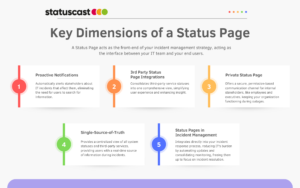At any moment, a small failure at any point in your complex web of IT systems can trigger an outage. As such, proactively establishing a method of clear and timely end user communication is the crux of effective incident response. For large organizations, these moments of downtime not only carry a massive opportunity cost, but also test the resilience of their operations. This is the point at which a status page can decide the outcome of an incident; is the incident a blip on the radar, or does it cascade into business failures that disrupt your entire organization and leave a lasting stain on your brand image in the mind of your customers. While your IT team relies on an incident management system internally to work toward resolving incidents, the status page acts as the front-end of your incident response, the external interface between IT and end users, keeping them informed of disruptions before they encounter them.
The Characters in the Status Page Story
Employees
Employees stand at the frontline, directly impacted by IT incidents that can disrupt their daily operations and workflows. Simultaneously, the impact on employees can represent the greatest cost of outages in the form of lost productivity. The status page serves as a crucial bridge between IT and other employees, connecting them with real-time updates and guidance amidst the tumult of chaos. When employees are kept in the loop during downtime, the path forward is illuminated and they are empowered to adapt workarounds and implement contingency plans. This helps to safeguard productivity and keep critical business operations that your employees tend to humming along. In essence, the status page ensures that your workforce remains informed, engaged, and equipped to navigate through disruptions without succumbing to the disruption of downtime.
Customers
For SaaS customers, the impact of IT incidents can disrupt critical processes and delay projects, which degrades customer experience and leads to churn. When services that customers rely on face disruptions, they can turn to the status page which offers real-time updates on ongoing issues, archives historical data on past incidents for context, and proactively notifies users about scheduled maintenance. This status page acts as a single-source-of-truth, which is an invaluable resource for SaaS providers to offer their customers, as their experience hinges on a complex web of interwoven services. By having access to detailed, real-time information, customers can quickly understand the nature and extent of any outage or degradation. This enables them to make informed decisions, perhaps activating alternative plans or adjusting timelines to mitigate the impact on their own clients and stakeholders. The status page helps to set clear expectations with updates and visibility into critical systems, which mitigates customer frustration during outages.
IT
Tasked with the monumental responsibility of navigating incident resolution, the status page significantly lightens the burden on IT by automating the outreach to stakeholders. Status page automation not only streamlines communication, freeing IT professionals to concentrate on solutions, but also aggregates crucial data from APM and Observability tools. By funneling this diverse information into a single, centralized platform, the status page minimizes the complexity of incident management. It emerges as a single pane of glass that IT can view incidents through, enabling them to efficiently pinpoint issues, strategize resolution, and ultimately, enhance the organization's capacity to withstand and recover from downtime.
Dimensions of an Effective Status Page

Proactive Notifications
A cornerstone of any effective status page is its ability to proactively notify stakeholders of incidents, updates, and resolutions. This ensures that information is pushed to end-users without requiring them to seek it out, thereby enhancing the effectiveness of such communications in producing efficiency savings and mitigating disruptions in normal operations for end users.
Third-Party Status Page Integrations
A status page integrates third-party status information offering a comprehensive view of the IT ecosystem, highlighting dependencies and potential points of failure. This integration is crucial for maintaining a seamless picture of critical services and makes life easier on users who no longer have to independently check the status of multiple different third party services.
Private Status Page
For internal stakeholders, a private status page provides a secure, permissions-based platform for communication. This ensures that sensitive information is shared with discretion, fostering an environment of trust and accountability within the organization.
Single-Source-of-Truth
Above all, a status page serves as a single-source-of-truth for end-users facing service disruptions. It offers a comprehensive view of all critical systems, components, and third-party services, displaying real-time data on their status. This clarity is invaluable, as is the consolidation of this information in one location, guiding stakeholders through the incident with maximum visibility.
The Role of a Status Page in Incident Management
A status page is a cornerstone of effective incident management. It facilitates a proactive approach to incident communication, enabling organizations to inform stakeholders about the status of services they rely on. The status page automates various aspects of this process, from the distribution of notifications to the integration of monitoring tools that identify incidents in the first place. This automation significantly reduces the burden on IT in the moment that they are under the most pressure, freeing them up to focus solely on resolving outages.
Moreover, a private status page is instrumental in internal incident communication, ensuring that the right people are optimally informed. It establishes accountability, identifies areas for improvement, and creates a feedback loop to enhance an organization's future incident response capabilities.
Conclusion
The incident resilience of an organization is measured not just by its ability to reduce the total amount of downtime they experience, but by its ability to reduce the magnitude of the impact of downtime when it does occur. The status page emerges as a critical tool in this endeavor, mitigating the effects of outages that degrade end user productivity and customer experience. By providing a real-time interface between IT departments and various stakeholders from employees to customers, it ensures that all stakeholders remain informed, engaged, and empowered to navigate the challenges of IT disruptions.





